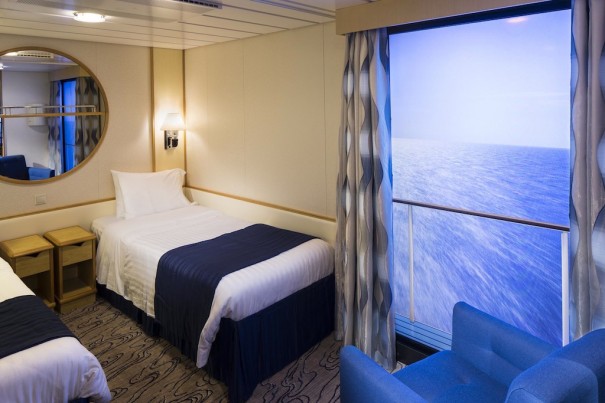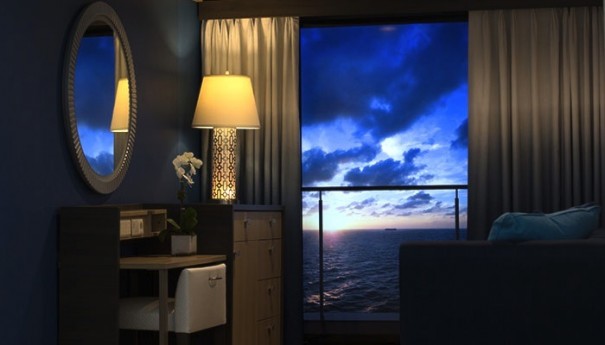Balcones virtuales de 80” y en HD en camarotes interiores para disfrutar del crucero en tiempo real
Recrear la navegación de un crucero en tiempo real y los diferentes momentos del día en un camarote interior es la innovadora apuesta de la compañía de cruceros Royal Caribbean, que ha instalado balcones virtuales con pantallas HD de 80” y tecnología de Control Group para mejorar el confort de sus clientes durante la travesía en tiempo real.
La compañía de cruceros Royal Caribbean ha decidido mejorar la calidad de los clientes que viajan en un camarote de interior con una innovadora solución: balcones virtuales compuestos por pantallas de 80 pulgadas en alta definición desarrolladas por la empresa norteamericana Control Group que simulan con el máximo realismo el exterior durante la travesía.
Esta iniciativa parte, según los responsables de Royal Caribbean, de “escuchar a nuestros socios de Crown & Anchor Society e hicimos los cambios que nos pidieron, ofreciendo una alternativa para los pasajeros que no deseen pagar más por un camarote con balcón, más difícil de conseguir”. Desde el presente mes de febrero, la compañía ha comenzado a instalar estos balcones virtuales en 81 camarotes interiores del Navigator of the Seas, uno de los barcos de su línea estadounidense que acaba de remodelarse.
Desafío audiovisual y físico
El concepto y diseño de estos balcones virtuales se basa en pantallas de alta definición de 80” enmarcadas y con una barandilla para simular un verdadero balcón, que se extiende de suelo a techo del camarote, y que muestran lo que sucede fuera del barco en tiempo real, de manera que los pasajeros que no cuentan con balcón exterior puedan disfrutar también del paisaje en su camarote interior, incluso en aquellos que no tienen ojo de buey.
Como explica Charlie Miller, de Control Group, “realizamos un balcón virtual con una pantalla HD enmarcada, con una barandilla con balaustrada simulada de seguridad y estratégicamente colocada con sus cortinas para recrear al máximo un balcón real. Pero esto iba mucho más allá de una cámara proyectada en una pantalla en tiempo real, ya que incorpora un innovador sistema de comunicación de fibra para evitar retrasos en la retransmisión del vídeo”.
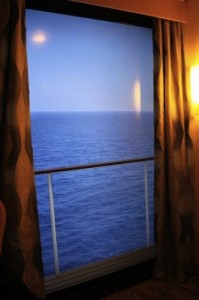 Si bien el concepto de balcón virtual parece en un principio algo muy simple, como recuerda Miller, “la labor tecnológica ha sido tremenda, con retos por todas partes que había que superar para ofrecer una experiencia tan humana y auténtica como fuera posible”.
Si bien el concepto de balcón virtual parece en un principio algo muy simple, como recuerda Miller, “la labor tecnológica ha sido tremenda, con retos por todas partes que había que superar para ofrecer una experiencia tan humana y auténtica como fuera posible”.
In this sense, Royal Caribbean probó previamente un balcón virtual de Control Group con unas treinta personas en su sede corporativa, cuyo denominador común fue que “una vista al mar abierto da un poco de miedo -recuerda Miller-, sobre todo cuando el barco está en movimiento en alta mar, por lo que la barandilla virtual era necesaria. Teniendo en cuenta, evidentemente, que nadie se puede caer a través de una pared, aunque esta sea una pantalla”.
Uno de los retos era que la barandilla virtual tenía que parecer que estaba fuera del ventanal, al igual que en una situación real, “y que los diferentes cambios de luz y del barco se reflejaran, lo que creaba un nuevo conjunto de desafíos visuales”, underlines.
Para superar este reto, los técnicos decidieron incorporar gráficos del movimiento del sol, así como datos del GPS de gran alcance para añadir sombras ‘reales’ y los aspectos más destacados de las barandillas virtuales. At the same time, se decidió no poner vidrio virtual entre los balaustres para aportar mayor realismo y que la imagen del océano lo ocupara. “
Nuevo reto: el movimiento del mar
Si el anterior problema fue relativamente fácil de resolver, el verdadero reto era reproducir el movimiento del océano. For this reason, los responsables técnicos Control Group decidieron consultar con expertos del MIT y de Harvard, “ya que teníamos que responder a las preguntas en torno a cómo la gente reaccionaría a una pantalla inmersiva en un pequeño lugar sin luz solar. Dos científicos del MIT y de Harvard nos asesoraron en el diseño de mecanismos que ofrecieran la mejor imagen pero que evitaran los desagradables efectos secundarios que se producen cuando las percepciones visuales de movimiento no se coordinan con sensaciones físicas reales”, detalla Miller.
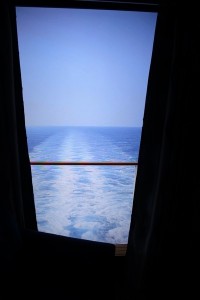 Esto significaba que se tenía que producir la mínima demora entre la alimentación de la cámara y la pantalla del balcón virtual. “La solución fue una avanzada y rara tecnología de canal de fibra que nos aconsejaron incorporar. Una vez que llegamos a una latencia inferior a un segundo ya no era un problema”, puntualiza Miller.
Esto significaba que se tenía que producir la mínima demora entre la alimentación de la cámara y la pantalla del balcón virtual. “La solución fue una avanzada y rara tecnología de canal de fibra que nos aconsejaron incorporar. Una vez que llegamos a una latencia inferior a un segundo ya no era un problema”, puntualiza Miller.
Uno de los elementos fundamentales de toda esta tecnología ha sido, como señala este responsable, incorporar la galardonada cámara de cine RED Epic de alta definición para captar las imágenes que los huéspedes verían en las pantallas, “instalamos una en la proa y otra en la popa de la nave. Se decidió que los mejores ángulos de visión no estaban a los lados de la nave, sino hacia adelante y hacia atrás. In fact, los camarotes que tienen balcones reales cuentan con estas mismas vistas, por lo que cada balcón virtual se ha situado en una pared lateral y no la pared de babor o estribor”.
Besides, a este desafío se sumaba que todo este engranaje tecnológico tenía que soportar la intemperie marina de sal y agua, el sol y el calor, el viento,… “Hemos superado todas las condiciones atmosféricas -confirma Miller-. El cable de fibra óptica lleva el vídeo a un servidor, next, a un decodificador que decodifica y procesa el vídeo antes de que aparezca en la pantalla, pero el verdadero triunfo es que no se produce ninguna latencia entre la cámara y la pantalla”.
Imágenes y audio
Los diseñadores optaron por incorporar a cada habitación con balcón virtual un mando a distancia para que los huéspedes tuvieran la posibilidad de elegir visualizar las imágenes del mismo o no, así como controlar el volumen de audio que se recibe de las cámaras exteriores, si bien no pueden cambiar los puntos de vista de proa y popa que ofrecen las cámaras anterior y posterior.
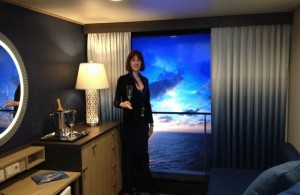 A este respecto, Ronnie Farzad, del departamento tecnológico y de entretenimiento de Royal Caribbean, señala que “esta decisión responde a la coordinación de las imágenes visuales con las sensaciones físicas. Al principio ni lo habíamos pensado, pero era necesario para evitar a los huéspedes caminar en la dirección equivocada y evitar una sensación molesta”.
A este respecto, Ronnie Farzad, del departamento tecnológico y de entretenimiento de Royal Caribbean, señala que “esta decisión responde a la coordinación de las imágenes visuales con las sensaciones físicas. Al principio ni lo habíamos pensado, pero era necesario para evitar a los huéspedes caminar en la dirección equivocada y evitar una sensación molesta”.
Otra decisión técnica fue utilizar un gran angular, una lente ‘ojo de pez’ en las cámaras, “puesto que nos ofrecen una representación mucho más exacta de las imágenes, como si se viera desde un balcón real, además de que se reduce de manera drástica la sensación de movimiento en la imagen. Lo único que falta en estos balcones, of course, es el aire fresco de la brisa del mar”.
La compañía también está instalando versiones más pequeñas de los balcones virtuales en los camarotes ‘studio’ para una sola persona.
Royal Caribbean no es la primera línea de cruceros en ofrecer una vista virtual en sus buques, aunque sí con esta avanzada tecnología. La flota de cruceros Disney fueron pioneros en ofrecer ojos de buey virtuales en sus cabinas interiores, con pantallas circulares de 42 pulgadas en las que se mostraba un canal de vídeo con las imágenes de una cámara en vivo instalada en la popa de la nave.
Did you like this article?
Subscribe to our NEWSLETTER and you won't miss anything.



